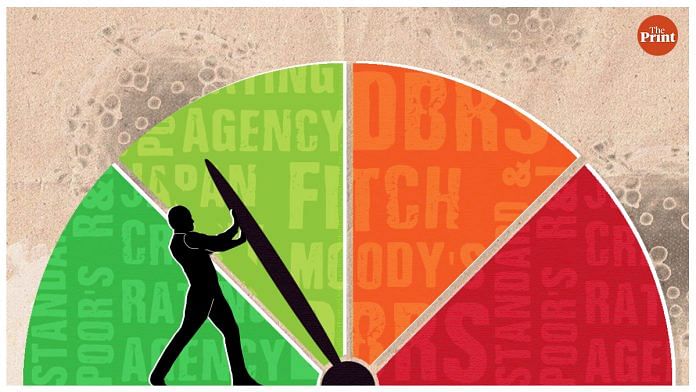The methodology of credit rating companies puts a country that is trying to get out of the Covid-19 pandemic in a bind.
If a government increases spending, its debt goes up, and so rating falls. If a government keeps spending under control, demand doesn’t pick up and the projected GDP growth lowers, raising the prospects of a downgrade.
As rating agencies continue with this standard approach developed for normal times even during these unprecedented times, an emerging economy rating and outlook appear to be worse regardless of whether its government is fiscally prudent or profligate.
Also read: Why Modi govt has walked a tightrope with new Covid relief package
What a downgrade could mean for an economy
Over the last few weeks, a number of rating agencies have cut India’s GDP growth forecast. Fitch Ratings cut India’s growth forecast to 10 per cent for the current year, from 12.8 per cent estimated earlier. Similarly, Standard & Poor’s has lowered its projections to 9.5 per cent for the current year from 11 per cent estimated earlier.
These estimates feed into their sovereign ratings. While S&P has maintained a stable outlook on India’s sovereign credit rating, they have cautioned that India could face a ratings downgrade if economic recovery is slower or deficits and debts exceed their projections.
A sovereign credit rating signals the creditworthiness of a sovereign. Governments seek higher credit ratings for easier access to international capital markets. These ratings also affect the ratings of other domestic borrowers in international markets.
Even when governments don’t borrow in international capital markets, like in India’s case, the country’s rating matters because foreign institutional investors like pension funds, banks and other portfolio investors have rules regarding what should a country’s rating be for them to invest in shares and bonds in that country. A downgrade could mean that many of them would have to exit.
How ratings are awarded
India’s sovereign rating is awarded by global rating agencies like Moody’s, S&P, Fitch, Japan Credit Rating Agency, DBRS and R&I. Each of these rating agencies has a methodology and a model to assess the creditworthiness of a sovereign.
Typically, they look at the economic growth prospects, fiscal and debt dynamics, and external sector strength, which includes current and capital account position and foreign exchange reserves, to assess the country’s creditworthiness.
For assessing the fiscal and debt dynamics, the key variables are the fiscal deficit and the change in general government debt-to-GDP ratio.
Keeping debt and deficit in control while giving growth a push is a tightrope walk. If a country borrows more and spends more to raise its economic growth, its fiscal and debt dynamics take a hit. If a country tries to maintain fiscal discipline by controlling its expenditure and borrowings, its economic growth may not see an immediate rise.
So, regardless of whether countries focus on higher growth financed by additional spending or on fiscal discipline, there is a possibility of fall in growth forecasts and ratings downgrade. This challenge becomes even more compounded during a Black Swan event like the Covid-19 pandemic.
Also read: Covid has undone years of gains India made after 1991 liberalisation
Why there seems to be a bias in assessment
While countries have responded to the Covid crisis through support measures through an expansionary fiscal policy, the scope for support varies depending on the ability to access low-cost funding.
Many advanced economies have implemented large-scale spending. However, support in emerging economies have been relatively smaller because of their limited ability to borrow and spend.
The rating agencies use the same metrics to assess the creditworthiness of all countries, but some studies have shown that their assessments are biased towards advanced economies.
Agencies give higher ratings to advanced economies regardless of their macroeconomic fundamentals, show studies. For instance, the US has retained top grades from most of the agencies despite its debt projected to be around 110 per cent of GDP.
One of the reasons why the US can afford to raise its debt and spending is because the US Dollar is the main reserve currency, which gives the country the capacity to sell bonds that are in high demand around the world at low interest rates.
As such, even if agencies consider downgrading the US, their rating does not matter. Previous episodes of rating downgrades show that in such an event, investors shun riskier assets and flock to US government bonds because of institutional soundness and liquid bond US treasury bill markets.
Investors have faith that the central banks of advanced countries will be able to address the potential implications of a downgrade.
Questions to ponder in India
Credit ratings matter more for countries without strong currencies, like India.
Since last year, the Narendra Modi government has initiated a number of support measures to mitigate the disruptive impact of the pandemic. The structure of most of the relief packages was made with an eye on the fiscal deficit. But a collapse in revenues has resulted in an elevated borrowing programme for both central and state governments.
The agencies have flagged concerns about India’s rising debt and deficit levels.
It is worthwhile to ask: how much debt is too much? Can there be an ideal debt-to-GDP ratio? Given that countries are at different stages of economic development, can countries be bench-marked against a median number? Should the metrics, which may be applicable in normal times, be applied to assess the creditworthiness in unpredictable times?
The rating agencies have cut their growth forecast for India citing slower recovery post the second wave. It seems that the agencies will disapprove whatever the government does.
Ila Patnaik is an economist and a professor at National Institute of Public Finance and Policy.
Radhika Pandey is a consultant at NIPFP.
Views are personal.
Also read: 7-year record: UPA raised petrol, diesel prices more than BJP, but global story was different



